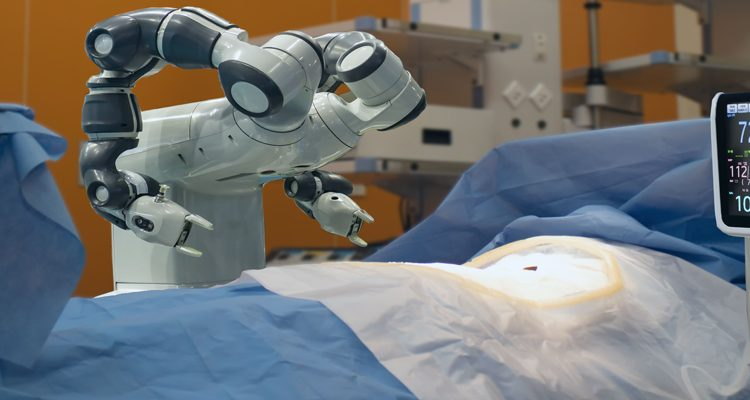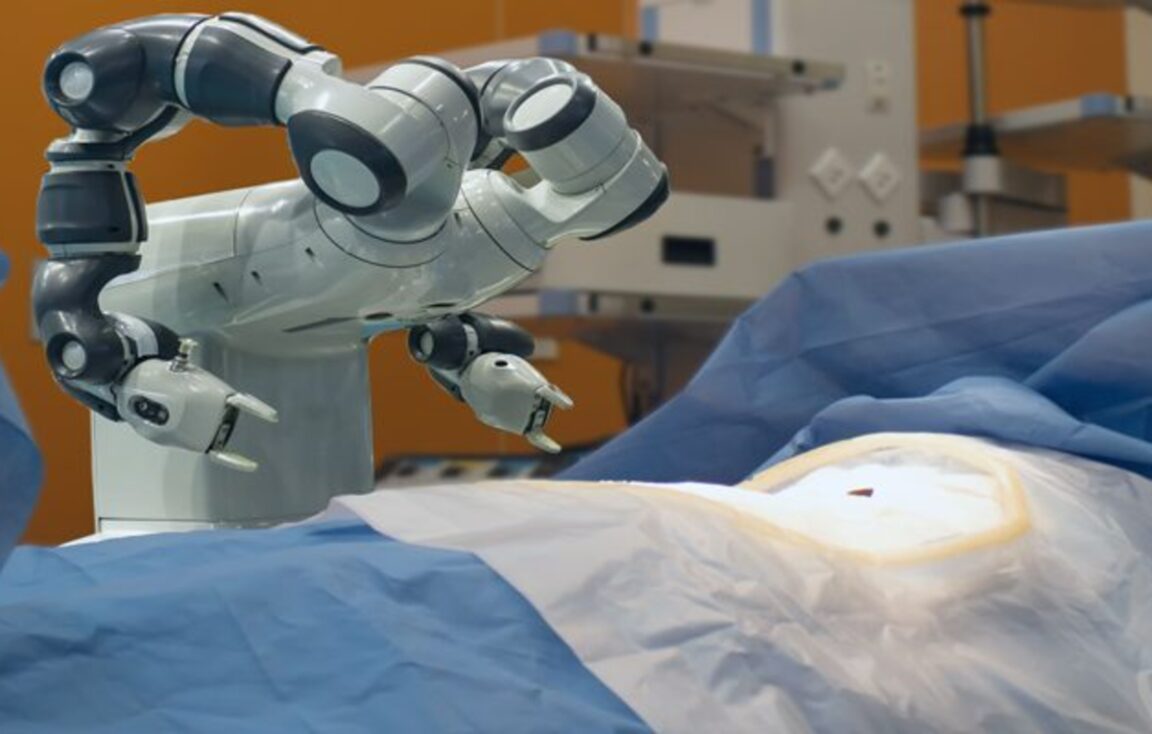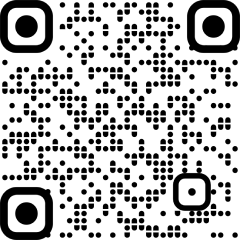
By Shruti Kharbanda
Robotics and AI is assuredly transforming healthcare.
The Global Medical Robots market is valued at $16 billion in 2024 and poised to more than double by 2029 to $33.8 billion, growing at CAGR 16.1 per cent from 2024 to 2029.
The concept of modern robotics began in 1920, when Czech writer Karel Capek first used the word “robot” in his play “Rossum’s Universal Robots”. He used the Czech word “robota” which means “forced labour”, because in the play the robots were a serving class and eventually rebelled against humans which leads to the end of humanity. The idea of medical robotics began in August 1942, when Robert Heinlein story ‘Waldo‘ introduced the medical robots with hand grips to control manipulators and cameras of various sizes for surgeries. In 1984, the first medical robot Arthrobot was used in Vancouver for orthopaedic surgery and responded to voice commands. Over the years, sensors, AI, computer vision and data analytics have transformed medical robots, expanding their capabilities towards more precise and efficient care.
Types of Medical Robotics
There are following types of medical robots either already available or being developed by innovators worldwide:
Surgical Assistance Robots
Robotics continue to revolutionise surgery by enabling minimally invasive procedures, which reduce recovery time, minimise scarring, and lower the risk of complications. Robotic systems are already widely used, and future iterations will likely offer even greater precision and autonomy. Integration of AI and computer vision allows robots to assist surgeons with real-time data analysis, improving decision-making during complex procedures and avoid nerves & muscles. Eventually robots will be able to take over minor surgeries and small sub-procedures under the watchful gaze of the surgeon.
Global Market size for surgical robot is valued at $11.72 billion in 2024 and is poised to reach $16.54 billion by 2028.\
Robotic Assistants in Patient Care
Robots equipped with telepresence capabilities can enable healthcare providers to remotely assess and interact with patients, making healthcare more accessible, especially in remote areas. With aging populations, robots could play a critical role in assisting the elderly with daily activities, medication management, and companionship. These robots can monitor health, alert caregivers, and provide physical assistance. As robots take on more roles in healthcare, the nature of patient-doctor interactions will also evolve. Ensuring that robots complement rather than replace the human touch in care will be crucial. Additionally with AI and computer vision, these robots could work as autonomous frontline medical professionals and provide emergency medical assistance until emergency services arrive.
Global Market size for robot nurse is valued at $1.02 billion in 2023 and expected to reach $3.61 billion by 2031.
Rehabilitation and Physical Therapy
Robotic exoskeletons are becoming prevalent in helping patients regain mobility after strokes, spinal injuries, or other debilitating conditions. These devices can aid in physical therapy by providing support and resistance during exercises. Furthermore, AI-driven robotic devices can assist in personalized rehabilitation, adapting to the patient’s progress and needs in real-time. These robots can also monitor a patient’s form as they perform exercises, measure degrees of motion, and track progress.
Global Market size for exoskeletons is estimated to be worth $0.7 billion in 2023 is growing at CAGR 38.6 per cent and expected to reach $3.7 billion by 2028.
Hospital Automation
Robots will automate many routine logistical tasks in hospitals, such as delivering supplies, medication, and food to patients, thereby reducing human error and freeing up healthcare workers to focus on patient care. Tasks may include preparing patient rooms, tracking supplies, filing purchase orders, restocking medical supply cabinets, and transporting bed linens to and from laundry facilities. Robots capable of disinfecting rooms and equipment with UV light or other methods will become standard, helping to reduce hospital-acquired infections. These robots will be closely integrated with the Hospital Management Systems and heavily use AI and computer vision technology.
Global Market size for hospital automation is valued at $1.5 billion in 2022 is growing at CAGR 13.5 per cent .
Advanced Diagnostics and Precision Medicine
Robotic systems equipped with AI and computer vision will enhance diagnostic accuracy by analysing medical images, pathology slides, and other data. This will lead to earlier detection and more personalized treatment plans. Robots will handle complex lab tests, improving the speed and reliability of diagnostic processes.
Precision medicine is tailored treatment and healthcare strategy for individual patients based on their unique genetic, environmental, and lifestyle factors. It utilizes detailed data about a person’s DNA, biomarkers, and other specific health information to deliver personalized care. Advanced Diagnostics Robots with AI will make precision medicine a reality with Genomics testing, proposing Targeted Therapy, leveraging big data analytics to guide personalized treatment plans and predicting an individual’s risk of developing certain conditions and intervening early.
Global Market size for Precision Diagnostics is valued at $85.34 billion in 2024 is growing at CAGR 13.1 per cent and expected to reach $229.27 billion by 2032.
Prosthetics and Implants
The future will see the development of more advanced, AI-driven prosthetics that offer greater mobility, dexterity, and sensory feedback, closely mimicking natural limb function. There may be advances in robotic implants that can monitor and adjust their functions in real-time, such as smart insulin pumps.
Global Market size for Advanced Diagnostics is valued at $8.38 billion in 2023, growing at CAGR 4.72 per cent and expected to reach $13.94 billion by 2034.
Education and Training
Medical training is using robotic simulators to provide hands-on experience without risk to patients. These systems will become more sophisticated, offering realistic scenarios for training.
Global Market size for Surgical Robotics Simulation was valued at $427.9 million in 2023, and is expected to reach $2.13 billion by 2033, growing at CAGR 17.31 per cent.
Challenges and Roadblocks
With every newly created or updated robotic system, robotics professionals and enthusiasts can see dozens of opportunities for future growth. But this growth is not without obstacles. The healthcare industry faces four unique challenges on the road to widespread adoption of robots: lack of patient trust, lack of skilled professionals, safety risks, and regulatory risks.
Advancements in robotics, AI, and cybersecurity are creating high demand for graduates with these backgrounds, the healthcare industry is facing a shortage of skilled professionals. To meet the future needs of robotics in healthcare, the industry needs to encourage students and healthcare professionals to pursue an education in robotics and related fields.
To address the unique safety risks, ethical, regulatory, and societal impacts posed by robotics in healthcare due to the amount of data collected, stored, and analysed by healthcare robots, healthcare facilities need dedicated roles to oversee the use and cybersecurity of robots. Careful regulation to ensure safety and efficacy may potentially slow the pace of innovation.
The Promising Future of Robotics
Implementing robotics in the healthcare environment will enable organizations to free up workers’ time for other important, non-automated tasks by completing monotonous, repetitive, and/or administrative tasks. Robotics in healthcare also helps eliminate time-consuming visits, shorten the duration of surgeries, create personalized treatments, and increase surgery success rates.
In surgical environments, robots provide enhanced ergonomics and comfort for surgeons, allowing for increased procedural volumes as surgeons are less fatigued. Robots also help eliminate human error in high-risk procedures using AI.
Advancements in robotics could enable robots to perform lab tests without human intervention, remove plaque from arteries, take tissue biopsies, and attack cancerous tumours. In the future, robots could also deliver targeted medication, provide patient care for minor issues, and speak to patients about their symptoms.
To realize the full potential of robotics in healthcare, medical practitioners need to stay aware of the latest developments in the field and embrace collaboration opportunities with robotics companies. Not only will advancements in medical robotics help save lives and improve efficiency, but healthcare practitioners will also enjoy their role in the fascinating process of developing highly sophisticated robotic systems.
The article is written by By Shruti Kharbanda, Robotics & AI Chairperson (Northern Region), Indian Chamber of Commerce.
(DISCLAIMER: The views expressed are solely of the author and ETHealthworld.com does not necessarily subscribe to it. ETHealthworld.com shall not be responsible for any damage caused to any person/organisation directly or indirectly)


